You can take the title of this blog as meaning either or both of two things: horses that are moving (in which case the word “moving” is an adjective), or the things a person does to move a horse (in which case the word “moving” is a gerund). The two things are related, which will turn out to be the theme of this blog.
This entry is the joint product of two people: myself as the anatomist and biomechanics scientist, and my business partner Jo Belasco as professional trainer. Jo and I have worked on what might be called “applied horse biomechanics” together for over ten years now, and although I wrote the words you see here, they only came into existence after lengthy conversations with her and discussion about this very post.
The impetus for writing this entry was that a horse friend wrote me in response to my post about the walk, saying that although he’s heard many trainers insist that a horse cannot move the leg it’s standing on, and that cues to move a specific foot need to be provided when that foot is off the ground, he doesn’t see how this can be so. “If it were true,” he wrote, “there would be no way to start a horse from the stop. Maybe the ‘rein or seat’ qualifiers are important here, but I had a horse that was so forward he would move if you simply relaxed the reins. . . All with no reference to influence with the foot on or off the ground.”
My friend’s comments made me think about the glib way we all short-cut biology to smoosh terms around in ways that give them meaning they were never meant to have, and the impact such short-cuts have on how we think about and deal with horses. So here’s some additional thought about the walk and the training practice of learning to cue a horse’s foot when it’s off the ground.
When people say you can’t move a horse’s foot unless it’s not on the ground at the time, they are really making a short-cut statement. The real statement should be: “If you cue a horse to move its foot when that foot is bearing weight at the time, the horse won’t be able to respond immediately and/or in the way you’ve asked. And because horses move quickly, even at a walk, if you cue them any later than the moment you feel their foot come up, you will be too late. They will have put their foot back on the ground before they have a chance to respond. Furthermore, you want to cue them early enough that their foot is not only still in the air, but able to be redirected to come down somewhere else than where it would have gone otherwise.” Yes, that’s a lot to say, but of course it’s why we speak in a short-cut.
Let’s consider, first, where this idea comes from, which is ostensibly the nature of the step cycle. A step cycle is the complete range of motion made by a limb from the time it leaves the ground to begin a step, through the time it advances and comes down again to the ground and bears weight, until it leaves the ground again to take a new step. The sequence of still images below shows one complete step cycle of the left hind limb of the same horse that was pictured in the walking blog I posted on October 12. The screen grabs are from the same slow-motion video I used there. The blue arrow I’ve added to the first frame shows the foot coming up off the ground to begin the step cycle. It’s a little hard to see that the heel is up in that image because of the way I reduced it to fit on the page. But the heel isup off the ground where the blue arrow is.
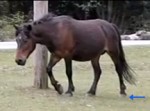 1. Left hind foot comes up from the ground as right front starts to come down and be placed. |
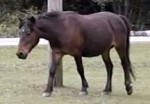 2. Left hind foot is clearly no longer supporting weight. Weight is now on the other 3 legs. |
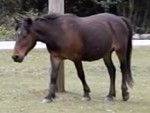 3. Left hind foot is now being brought forward again, though toe is nearly dragging on the ground in this horse. |
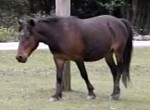 4. Left rear continues to come forward, now passing in front of the right rear foot (which remains in place, here). |
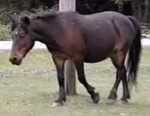 5. Left rear moves a lot farther forward and approaches the ground |
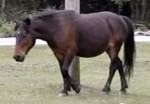 6. Left rear foot is placed on the ground, well in front of right rear foot. |
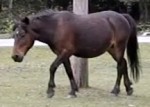 7. Left rear foot is bearing weight as right rear foot now comes up. (Left front is coming down, so notice that weight is presently on only two feet.) |
 8. Left rear foot is still weight-bearing, but right rear foot is now being brought in front of it. Weight is on 3 feet at this time. |
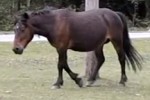 9. Left rear foot still weight-bearing but body is now being thrust in front of that foot as right rear foot approaches the ground. |
 10. Left rear foot is now behind the horse but still fully flat on the ground. |
 11. As horse prepares to lower right front foot to the ground, weight begins to shift off of left hind foot, though it is still on the ground. |
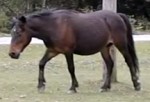 12. Left rear foot begins to come up from the ground as right front foot touches down. This is just barely past the same part of the step cycle shown in picture 1. |
You will notice several things in this sequence, if you look closely, all of which give you a little better understanding of the walk. First, the horse is moving its body forward (the whole point of walking) by pushing the foot back against the ground during part of the step cycle. So the position of the foot we’re watching changes with respect to where the horse is. When the foot is coming up off the ground in the first frame, it looks to be about 4 feet to our right of the vertical wooden post, which is at that time behind the middle of the horse’s neck. Mid-way through the step cycle, in frames 6 – 9, the horse’s left hind foot is fully on the ground and supporting weight. It has been brought forward about 2 feet, so now it is only about 2 feet to the right of that post. At this point, the post is behind the horse’s withers (in 6) and then the end of the back (9). By the time we get to the last frame, where this back left foot comes up off the ground again, it’s still about 2 feet to the right of the post — but now the horse has advanced so far forward that the post is behind its rump.
Many trainers say a rider could ask this horse to move that back left foot in about frames 1 through 3, when it’s come up off the ground and has not yet been set back down. So they teach riders “feel” of the feet so they can tell when that particular foot is in the position shown in frames 1 through 3 — and that’s when they cue the horse to set that foot down someplace other than they were about to put it. These trainers believe that if the horse is asked to redirect that foot between frames 6 and 11, the horse won’t be able to respond even if it wants to because it is standing on that foot and therefore unable to move it (unless it breaks its gait by hitching or stumbling). In the case where you are asking a loping or cantering horse to change its lead, there is even the possibility that it will respond on one end (that can respond at that moment) but not the other (which can’t), with the result that it cross-leads if you ask for a change of lead while the back foot that needs to move is on the ground.
Because of my biological background, I was actually suspicious of this idea for quite a while. The reason is that neurological researchers spend a lot of time considering what they call Reaction Time (or “RT”, because of course it has to have a catchier and geekier name than just “Reaction Time” if you study it in your lab). To get an idea of the level of discussion about how long it takes a body part to respond to a stimulus, and the kinds of factors that impact this response, here are abstracts of a couple of scientific papers on the subject from the National Academies of Science and the American Psychological Association. What you will see, besides the designation “RT” and other jargon that might make you reach for a pain reliever, is that moving a foot in response to a cue is not a simple matter of stimulus-response. There is a lotthat affects how quickly a motor response is expressed when any animal hears, sees, or feels something — which is to say that how quickly a horse moves a foot in response to the touch of a heel or rein is not a simple matter of picking the “one right part” of the step cycle to offer the cue (stimulus).
Researchers in RT want to know how quickly a human being can respond to switch off power to an engine if an alarm sounds, for instance, so most of the work on Reaction Time is on human beings. If you wade through those abstracts, you will see that their work suggests that a person’s reaction time can vary according to things like practice, the kind of stimulus presented, how many response options exist (in other words, do you have to decide whether to flip the lever or push the button, or is there only one choice), the nature of the on-going task or activity, and how much attention is being paid to specific parts of the environment. Just to show you how important these factors are, visualize for a moment the memory of an experience I’m sure you’ve had — a sudden loud noise or sharp motion startles a horse, which proceeds to leap straight up into the air with all four feet at once. It might have had all its feet on the ground a split second before, but the nature of these other factors changed its “normal” Reaction Time dramatically.
Most of us hope we don’t generate that kind of reaction in our horses. The point is that when we talk about “when our horse can move a foot in response to our cue,” we are actually talking about Reaction Time whether we realize it or not. And, given that we are, it’s a much more complex phenomenon than we imagine. A lot of things, including training, can impact how quickly our horse responds to a stimulus-cue. Furthermore, even though the Reaction Time for a foot placed squarely on the ground may be longerthan if it was in the air when we cue it, that Reaction Time still exists. A foot that is on the ground when we cue it can and will (if the horse chooses) react to our cue when it come up off the ground a few seconds later.
In the worst case scenario, the horse might react to the cue with a different foot and get a bit tangled up, which is how it’s said that cross-leading can happen by accident, or the delay of responding with the correct foot might lead to a bit of ungainly movement. But most of us who ask at the “wrong” or “sub-optimal” time don’t usually wind up with our horses tripping all over themselves. Usually what we get is movement in the direction we want, just a bit later than we asked for it — which is actually usually ok with us. Few of us are engaged in activities that require our horse to move a particular foot at a particular time in order to, say, keep from falling into a hole in the ground. So a little-bit-late response is just fine.
Or at least, this is what I thought until I saw a Tom Dorrance video about learning to move a horse’s feet individually while riding it. In this particular video, Tom Dorrance worked with some riders and their horses and a pattern of tires laid on the ground, to help the humans figure out how to tell where the horse’s feet were at all times and respond to their horse and the tires. The point of the exercise was to develop feel. The demonstration of feel was that the rider could move a horse’s foot exactly and precisely at the time desired, to the place desired. So there was discussion in the video about feeling when the foot came up off the ground and giving the cue then, as is standard in this type of training. The result was astounding and unexpected. Remember, I was pretty jaundiced about the idea that a cue has to be tied so closely to the step cycle because I had a healthy respect for the complexity of Reaction Time. But every rider who engaged in this exercise, and learned how to feel where the feet were and to cue them at the “appropriate” times developed an incredibly light and responsive riding relationship to the horse s/he was on.
Jo uses some of Tom Dorrance’s methods when she gives riding instruction, and she’s the one who developed the closed-eyes on a bareback horse walking exercise I described in my previous post. Sure enough, she found — and I saw it was so — that when people learned to feel their horse’s feet coming up off the ground and paid attention to it enough to cue them “at the right time,” they got light and responsive movement from the horse. I also saw other trainers working on teaching the same “learn to feel when the foot comes up and cue it then” method in clinics in a variety of riding disciplines, and again I saw that when riders began to develop feel of their horse’s foot positions, a light and responsive relationship blossomed into existence. The uniformity of this response shocked and amazed me, especially given the huge variation in different trainers’ means of explaining and teaching the concept. But as long as the rider finally learned to feel the horse’s feet, the response materialized. So clearly something important was going on. But what?
Remember that we know Reaction Time is not solely or even primarily dependent on the timing of the stimulus or cue, but instead a complex phenomenon. So we have an “effect” here, which is a light and responsive horse, the “cause” of which cannot be, biologically, simply applying the stimulus at precisely the right time. To find the actual cause, we must consider what else all these experiences have in common. And what they have in common is this: the human learns to feel where the horse’s feet are all the time, and learns it so well that a cue can be offered at one particular point in the step cycle of one particular leg. Notice which words are in bold and italics. It’s about what the human learns.
A human who learns to feel where his or her horse’s feet are is thinking about, and even physically connected with, the horse. That human’s mind is no longer inside their own ego and their own intention — at least for a while. Instead, they are focusing on the horse. They are feeling the horse, quite literally. And Jo and I both suspect, very deeply, that what happens is that this change in focus and concentration allows the horse and rider to communicate simply and effectively in an entirely different way than the one we usually think of as “stimulus-response.” Which means, of course, that Reaction Time is irrelevant. What matters is simply the development of feel. And an exercise in which you learn where your horse’s feet are — with such precision that you can cue one at one particular place in the step cycle — will teach you that. But the exercise is not about cuing the horse. It’s about teaching the human to feel.
If you read Tom Dorrance, Bill Dorrance, or Ray Hunt you will see that this is pretty darned close to the way theytalk about “feel”. And given that they coined the concept, at least in contemporary equine society, that’s enough for me to take it as a “good fit” to the only explanation I can see for what happens in these riding exercise — given that the neurobiological “reason” usually given (Reaction Time) is actually not valid. Did Tom Dorrance know this when he used a line of tires to teach a rider how to tell where his horse’s feet were, and how to move each foot at just the right time? Was he actually and simply trying to teach “feel” in a reliable way? Yes, I think he was.
In my walking blog, when I suggested ways a person could develop feel of their horse’s walking foot positions, my thought was that I’d give lip service to the “reason” this is usually said to be a good thing to do: Reaction Time, or “you can’t move a foot that’s not off the ground.” It was, after all, good enough for Tom Dorrance in that clinic I saw in a video. But my real thought was that anyone who did that exercise would develop proprioceptive awareness of the horse they were sitting on. And I do believe, after all I’ve seen and after the training work Jo has done to explore this, that if you do this exercise you will develop your sense of “feel” and, as a result, start to develop a relationship of light responsiveness between you and your horse.
If it works better for you to skip all the talk about “feel” and use the short-cut of thinking that you can’t move a foot that’s on the ground, that’s fine. You will still learn where your horse’s feet are and when to cue a foot to move. And that will get you light and responsive movement from your horse. But you’ll need to pretend you don’t know about the complexities of Reaction Time if you do that — which is ok by me. The complexities of the natural world get abridged in common understanding all the time, largely for the reason of generating actions that have simple and predictable outcomes that seem to be based in science. But, as is usually the case in all such situations, understanding the science a little better actually takes you to a place you might not expect to wind up.
So if your horse already knows how to “go” and all you have to do is relax the reins, you’re in good shape in lots of ways. But an exercise that teaches you to feel where your horse’s feet are, well enough that you can cue one foot at one particular place in the step cycle, will still give you something new that’s worth developing: feel. Horses already know how to walk, after all. It’s we humans who have to learn how to go along for the ride without messing them up.
Dawn Adams, Ph.D.
Copyright 2012 Dawn Adams, Ph.D. Do not reproduce in any format without written permission from Dr. Adams.
The Rider Marketplace
International Horse News
© 2025 Created by Barnmice Admin.
Powered by
![]()
-
Quick Links
- Horse Blogs
- Horse Forums
- Horse Videos
- Horse Photos
-
Sister Sites
- The Rider Marketplace
- The Rider
- Equine Niagara News
-
Helpful Links
- Advertise With Us
- Barnmice Tour
- Feedback
- Report an Issue
- Terms of Service
© Barnmice | Design by N. Salo